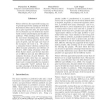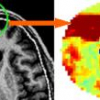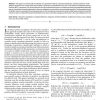2261 search results - page 151 / 453 » Supervised Topic Models |
78
Voted
JMLR
2010
14 years 5 months ago
2010
Feature selection for supervised learning can be greatly improved by making use of the fact that features often come in classes. For example, in gene expression data, the genes wh...
93
Voted
ACL
2011
14 years 1 months ago
2011
Unsupervised vector-based approaches to semantics can model rich lexical meanings, but they largely fail to capture sentiment information that is central to many word meanings and...
101
Voted
CVPR
2010
IEEE
15 years 6 months ago
2010
IEEE
We present two novel methods to automatically learn spatio-temporal dependencies of moving agents in complex dynamic scenes. They allow to discover temporal rules, such as the rig...
87
Voted
ISBI
2002
IEEE
15 years 11 months ago
2002
IEEE
This paper presents a statistical shape model for automatic skull stripping of MR brain images. A surface model of the brain boundary is hierarchically represented by a set of ove...
63
Voted
PAMI
2006
14 years 10 months ago
2006
This paper is concerned with the selection of a generative model for supervised classification. Classical criteria for model selection assess the fit of a model rather than its abi...



